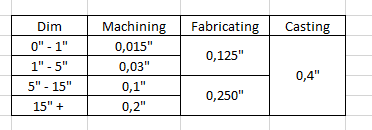Mannes Karsten
Petroleum
Hi,
Quick question;
On an old rotor assembly drawing we received, there's a table with general tolerances ('unless otherwise specified'). Now in this tolerance table there are 3 columns: Machining, fabricating, casting.
I only know certain ISO-norms, such as ISO 2678-mK. I'm unfamiliar with the 'machining, fabricating, casting' tolerance table on a drawing.
What does the 'fabricating' column refer to? Is it to the assembly of parts? Does it refer to the fabrication of raw material? Something else?
Quick question;
On an old rotor assembly drawing we received, there's a table with general tolerances ('unless otherwise specified'). Now in this tolerance table there are 3 columns: Machining, fabricating, casting.
I only know certain ISO-norms, such as ISO 2678-mK. I'm unfamiliar with the 'machining, fabricating, casting' tolerance table on a drawing.
What does the 'fabricating' column refer to? Is it to the assembly of parts? Does it refer to the fabrication of raw material? Something else?

